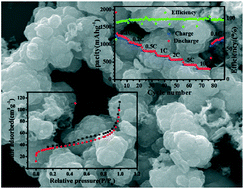Fe3O4–carbon nanocomposites via a simple synthesis as anode materials for rechargeable lithium ion batteries
Abstract
Fe3O4–carbon nanocomposites have been synthesized simply with a hydrothermal method free of template that is followed by an annealing process. The morphological and compositional analysis reveals that the inter-separated Fe3O4 nanocrystals with a size of ~10 nm are homogeneously embedded within the mesoporous carbon matrix. The interesting configuration is evaluated by scanning electron microscopy (SEM), transmission electron microscopy (TEM), Raman, energy dispersive spectroscopy (EDS), and X-ray diffraction (XRD). Benefiting from the advantages of good buffering and electric conductivity, the nanocomposite delivers an initial capacity of 1706 mAh g−1 at 0.2 C (1 C = 1 A g−1). Besides excellent lithium storage capability, it exhibits a superior cycling stability with more than 100% capacity retention after 100 cycles at 0.2 C and 1 C. When successively discharging at variable rates, the nanocomposite retains a reversible capacity of 1249 mAh g−1 at 0.1 C, 690 mAh g−1 at 1 C, and 311 mAh g−1 at 10 C. With excellent capability and rate performance, the Fe3O4–carbon nanocomposites may be a promising anode material of lithium ion batteries (LIBs) for the green large-scale production.


 Please wait while we load your content...
Please wait while we load your content...